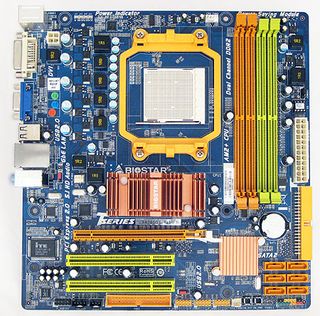Seven AMD 785G-Based Motherboards Rounded Up
Biostar TA785GE 128M: Features And Hardware

Biostar's TA785GE 128M distinguishes itself in this roundup as one of the two products that uses DDR2 memory instead of DDR3. As such, we can consider this a board that will be especially attractive to the upgrade crowd. The only drawback is that both of the DDR2 boards claim 125W CPU limitations, unlike their DDR3 counterparts. This means that the fastest CPU this board will officially support is the Phenom II X4 955, as the new Phenom II X4 965 is considered a 140W part. Having said that, nobody is going to miss that 200 MHz difference at stock speeds, but those who plan on upgrades to AMD's future product stable might want to consider the DDR3 motherboards with 140W CPU support. Moreover, if you're into overclocking, the lower wattage ceiling could prove problematic when you push higher clocks.
Conversely, being a DDR2 AM2+ board affords the flexibility of supporting the entire range of AM2+ CPUs, including the original Phenoms, AM2 Athlon X2s, Athlon IIs, and Phenom IIs. Aside from this, the Biostar solution boasts 128MB of DDR2 SidePort memory, like any other serious Radeon HD 4200-based offering.
Other features include G.P.U. Green (disables extra power phases under light loads to save power; the G.P.U. stands for “green power utility” and not “graphics processing unit"), O.N.E. (this is a set of three overclocking profiles in the BIOS that offers increasing levels of performance), and the Tseries OC Utility (Biostar's Windows-based overclocking tool).
This model also separates itself from the pack with internal power and reset buttons, but unfortunately falls short of the full enthusiast wish list with no clear CMOS button.
The bundle doesn't offer any surprises and includes requisite IDE cable, two SATA cables, an I/O shield, a manual, and a driver CD. As a bonus that might be appreciated by upgraders, there is a Molex-to-SATA power adapter.

The TA785GE doesn't need epic power to handle its 125W CPU specification, so the standard 24-pin ATX power cable is accompanied by a four-pin ATX 12V auxiliary connector. The 24-pin ATX cable is placed centrally, where I like it to be. The four-pin ATX 12V plug is where it usually lands, on the top-left of the board (inconvenient in cases where the PSU is mounted on the bottom of the case).
Being a microATX product, there's not a lot of space for expansion slots. But there is a single x16 PCIe 2.0 slot for discrete graphics and two standard PCI slots for legacy devices. Other missing features are an HDMI output, FireWire controller, and eSATA interface. The most puzzling omission is the lack of HDMI output on a 785G board, as home theater is one of this chipset's core targets. I wouldn't be as concerned if Biostar had included a DVI-to-HDMI adapter in the bundle.
Stay on the Cutting Edge
Join the experts who read Tom's Hardware for the inside track on enthusiast PC tech news — and have for over 25 years. We'll send breaking news and in-depth reviews of CPUs, GPUs, AI, maker hardware and more straight to your inbox.
The primary IDE and SATA plugs are where we like to see them: to the bottom-right, easily accessible, and out of the way. The floppy drive connector is kind of far away from the drive bay.
One final note for audiophiles: the Biostar TA785GE 128M is the only board that offers a 5.1 channel HD audio codec (Realtek's ALC662) instead of a 7.1 channel codec like those featured with every other board in the roundup. It is also the only board in the roundup without a digital audio output option.
Current page: Biostar TA785GE 128M: Features And Hardware
Prev Page Asus M4A785TD-V EVO: BIOS And Overclocking Next Page Biostar TA785GE 128M: BIOS And Overclocking-
JohnnyLucky Very informative article. Nice to see there are motherboards with different features for different users/tasks.Reply -
bpdski Great article, I think this shows pretty conclusively that there is no benefit to upgrading to an AM3 based system. If you already have an AM2+ system, you can easily just drop in a new CPU and you system will be every bit as good as a brand new system with DDR3. You just need to make sure your motherboard supports the power requirements of whatever you want to drop in.Reply -
jonpaul37 Hooray AMD for having cheap solutions in these hard-economic times!Reply
Boo @ Intel! i like the product, but my wallet & Girl do not like the cost! -
jonpaul37Hooray AMD for having cheap solutions in these hard-economic times!Boo @ Intel! i like the product, but my wallet & Girl do not like the cost!+1Reply
Girl has more money for clothes! -
ominous prime Well bpdski there is no point upgrading if you're AM2, but if you're building a new PC AM3 is the way to go in terms of your computers longevity. Very informative article.Reply -
sonofliberty08 thanks alot for the info , my first choice was allways asus , but now i now what i need when im going to unlock core , and now i saw the benefits of sideport memory .Reply -
duzcizgi ReplyWe were successful in achieving a 900 MHz stable overclock with the integrated graphics chipset by setting the BIOS to increase northbridge voltage by +.210mV.
Well, .210 mV = 210 microvolt. I don't think it would make much of a change. Maybe it is 210 mV or, .210 V. :) -
doron "Now we're seeing another benefit for the AM2+/DDR2 boards: both the Foxconn Cinema Premium and Biostar TA785GE 128M are drawing less power than their AM3/DDR3 counterparts."Reply
How comes? Didn't we all agree a long time ago that ddr3 supposed to be more energy efficient out of the two? (Lower voltage and stuff?) -
DarkMantle Great article, this will help a lot of people to make their AMD budget motherboard choice easier, thank you Don.Reply
Most Popular

